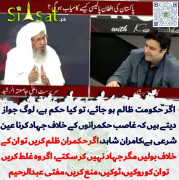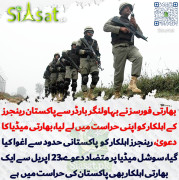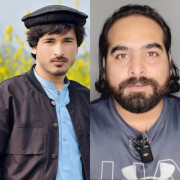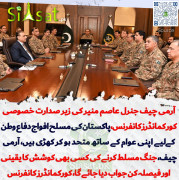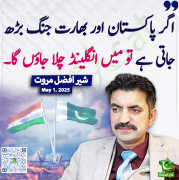Sher_ka_Shakari
Senator (1k+ posts)
Amir Mateen
The biggest mystery about Imran Khan remains his ideology. You will be as confused as anybody else if you try to explore the question in classical ideological terms.
For all we know, Imran has cooked this broth of moderate rightists and religious extremist with a little garnishing of liberalism. And then topped by a pinch of ultra-liberal salt sprinkled by, lets say, Jemima who remains his biggest supporter despite their divorce. How cute.
The PTI had shades of all this in its Lahore rallysomething of everything. Imran Khans speech was noticeably laced with religious references that should have appealed to the religious right. But his support for a dialogue with Taliban, ironically now adopted by his political detractors also, made him equally attractive to religious extremists.
He also used Shia references, touched a chord or two with the Saraikis, Sindhis and the Baloch. For the liberals, the whole ambiance was mouth-watering. It looked more as a picnic than a rally: live music being played by top stars; women on stage dancing; young girls in jean as well as head-scarves waving to the beats and boys, well, were just being boys. From elite women flaunting designer clothing to middle class families to ordinary labourersthe rally represented a potpourri of classes, ages, sects, areas and gender.
So how will you define this mishmash? But then what do you expect from a cricketer-turned-politician. Perhaps it is wrong to interpret his all-rounder approach in classical ideological terms. It makes perfect political sense. Imran Khan is largely eyeing for the traditional rightist vote. Call it what you may - Muslim Leagui, centre-of-the-right, Jamaati or Taliban - he is coming after Nawaz Sharifs votebank. For he knows that his main fight is with Nawaz Sharif and in Punjab.
This was the reason that Imran Khan accepted Jamaat-i-Islamis offer of electoral understanding with open arms. Jamaat sees Imran Khan as Turkeys Tayyip Erdogan, a tie-wearing moderate but a rightist nevertheless. Remember Erdogan was the prodigy of Erbakan, a Jamaat favourite who was barred from politics because of his extreme religious views.
Jamaats shalwar-qameez wearing, bearded cadres need an icon as Imran Khan, somebody with whom the masses could identify. Jamaat has pockets of organised cadres in every Punjab constituency but they are not enough to win even a single seat without a mainstream coalition - read PML (N). But they have had enough of Nawaz Sharif. Imran Khan is also in a similar situation. He has got pockets of votes but they are not big enough. So far, that is. This makes the PTI-JI electoral understanding a perfect combination, particularly in Khyber Pashtunkhwa where this electoral coalition will impact at least 15 National Assembly and 30 provincial seats.
The PTI hopes that it might also steal a sizeable chunk of left votes because of its cosmetic liberalism. There is also an underlying assumption that the demoralised PPP voter in Punjab will not vote for Nawaz at any cost - such being the decade long rivalry called dharabandi - and the PTI might reap that as a windfall. And this is quite possible, such being the PPP disenchantment with Asif Zardari and Co.
The PML-N feels secure in the fact that they have gathered the biggest stable of electables in Punjab - the political morality that Nawaz Sharif liked to propound in earlier days be damned. They have reasons to be confident based on old-style mathematics. The PTI might give them competition in urban seats, which are just about 30 out of the total 107 seats in the Central Punjab. Even if one takes out 20 more seats that are partially urban, and also concede a few seats to PTI in Rawalpindi and Sargadha Divisions, this still leaves at least 50 National Assembly seats in rural Lahore, Gujranwala and Faisalabad Divisions that have not been touched by the PTI. The PML -Q stands vanquished in this biradri-infested land of traditional turncoats and the PPP candidates are in deep trouble. And Imran Khan hardly has any notable candidate.
This is where the actual electoral Panipat war will be fought.
Nawaz Sharif may have his reasons to be secure but things might change if PTI manages to sway the popular mood. Imran Khan remains the wild card in this election. His exact strength remains difficult to assess because he boycotted the last election and the PTI was hardly a party in 2002. So this leaves little statistical data to assess the electoral situation.
The existence of so many imponderables makes it even more complicated. For instance, 35 million voters have been wiped off the electoral rolls and a new 40 million largely young new voters have been added. Here we are talking about almost 50 percent of the votes. We have no data to suggest which way they will float. A dozen nationalist and religious parties did not participate last time and their re-entry will definitely impact the equation. The last elections were reasonably fair but still the government machinery was used by the Musharraf government. The conditions are totally different this time around. A relatively independent caretaker governments exist. The Election Commission is powerful as never before and the judiciary remains increasingly vigilant. There will be a camera overseeing every polling station and the television channels will compete with each other in providing information and debate -the kind that the public may have never experienced before.
So it is under these circumstances that Imran Khan makes his entry. About his ideology - who cares?
The biggest mystery about Imran Khan remains his ideology. You will be as confused as anybody else if you try to explore the question in classical ideological terms.
For all we know, Imran has cooked this broth of moderate rightists and religious extremist with a little garnishing of liberalism. And then topped by a pinch of ultra-liberal salt sprinkled by, lets say, Jemima who remains his biggest supporter despite their divorce. How cute.
The PTI had shades of all this in its Lahore rallysomething of everything. Imran Khans speech was noticeably laced with religious references that should have appealed to the religious right. But his support for a dialogue with Taliban, ironically now adopted by his political detractors also, made him equally attractive to religious extremists.
He also used Shia references, touched a chord or two with the Saraikis, Sindhis and the Baloch. For the liberals, the whole ambiance was mouth-watering. It looked more as a picnic than a rally: live music being played by top stars; women on stage dancing; young girls in jean as well as head-scarves waving to the beats and boys, well, were just being boys. From elite women flaunting designer clothing to middle class families to ordinary labourersthe rally represented a potpourri of classes, ages, sects, areas and gender.
So how will you define this mishmash? But then what do you expect from a cricketer-turned-politician. Perhaps it is wrong to interpret his all-rounder approach in classical ideological terms. It makes perfect political sense. Imran Khan is largely eyeing for the traditional rightist vote. Call it what you may - Muslim Leagui, centre-of-the-right, Jamaati or Taliban - he is coming after Nawaz Sharifs votebank. For he knows that his main fight is with Nawaz Sharif and in Punjab.
This was the reason that Imran Khan accepted Jamaat-i-Islamis offer of electoral understanding with open arms. Jamaat sees Imran Khan as Turkeys Tayyip Erdogan, a tie-wearing moderate but a rightist nevertheless. Remember Erdogan was the prodigy of Erbakan, a Jamaat favourite who was barred from politics because of his extreme religious views.
Jamaats shalwar-qameez wearing, bearded cadres need an icon as Imran Khan, somebody with whom the masses could identify. Jamaat has pockets of organised cadres in every Punjab constituency but they are not enough to win even a single seat without a mainstream coalition - read PML (N). But they have had enough of Nawaz Sharif. Imran Khan is also in a similar situation. He has got pockets of votes but they are not big enough. So far, that is. This makes the PTI-JI electoral understanding a perfect combination, particularly in Khyber Pashtunkhwa where this electoral coalition will impact at least 15 National Assembly and 30 provincial seats.
The PTI hopes that it might also steal a sizeable chunk of left votes because of its cosmetic liberalism. There is also an underlying assumption that the demoralised PPP voter in Punjab will not vote for Nawaz at any cost - such being the decade long rivalry called dharabandi - and the PTI might reap that as a windfall. And this is quite possible, such being the PPP disenchantment with Asif Zardari and Co.
The PML-N feels secure in the fact that they have gathered the biggest stable of electables in Punjab - the political morality that Nawaz Sharif liked to propound in earlier days be damned. They have reasons to be confident based on old-style mathematics. The PTI might give them competition in urban seats, which are just about 30 out of the total 107 seats in the Central Punjab. Even if one takes out 20 more seats that are partially urban, and also concede a few seats to PTI in Rawalpindi and Sargadha Divisions, this still leaves at least 50 National Assembly seats in rural Lahore, Gujranwala and Faisalabad Divisions that have not been touched by the PTI. The PML -Q stands vanquished in this biradri-infested land of traditional turncoats and the PPP candidates are in deep trouble. And Imran Khan hardly has any notable candidate.
This is where the actual electoral Panipat war will be fought.
Nawaz Sharif may have his reasons to be secure but things might change if PTI manages to sway the popular mood. Imran Khan remains the wild card in this election. His exact strength remains difficult to assess because he boycotted the last election and the PTI was hardly a party in 2002. So this leaves little statistical data to assess the electoral situation.
The existence of so many imponderables makes it even more complicated. For instance, 35 million voters have been wiped off the electoral rolls and a new 40 million largely young new voters have been added. Here we are talking about almost 50 percent of the votes. We have no data to suggest which way they will float. A dozen nationalist and religious parties did not participate last time and their re-entry will definitely impact the equation. The last elections were reasonably fair but still the government machinery was used by the Musharraf government. The conditions are totally different this time around. A relatively independent caretaker governments exist. The Election Commission is powerful as never before and the judiciary remains increasingly vigilant. There will be a camera overseeing every polling station and the television channels will compete with each other in providing information and debate -the kind that the public may have never experienced before.
So it is under these circumstances that Imran Khan makes his entry. About his ideology - who cares?
Last edited:

